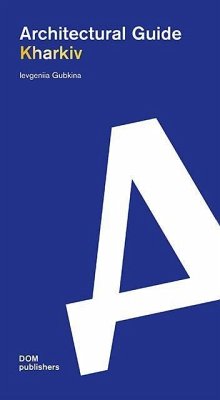Today Kharkiv's unfortunate geographical position on the eastern edge of Europe makes it a frequent target for the Russian army's relentless shelling and airstrikes. Yet, not long ago, Ukraine's second-largest city was a vibrant centre of student life, progressive art, intellectual thought, and techno-logical innovation, all spiced by the tough post-industrial identity of its citizens. Born from waves of migration, modernisation, industrialisation, and revolution, Kharkiv trod a stormy path from its origins as a Cossack military fortress to a period (1919-1934) when it was the capital of the Ukrainian Soviet Socialist Republic. This decade and a half was a golden age, marked by a dramatic construction boom that turned Kharkiv into a legendary Modernist city. In this publication author Ievgeniia Gubkina takes the reader on a journey through the city's history and architecture, from its Old Centre to its New Centre, home to Derzhprom, a Constructivist gem which was also the embodiment of a new model of social and economic relations. This architectural guide is a tribute to the indomitable spirit of freedom of Kharkiv's citizens. But it is also an important act of remembering and resistance: in documenting the city's buildings in words and photographs even as many of them are, day after day, being destroyed by Russian bombs, it keeps them intact and alive in our minds as a model for the city's future.
Perlentaucher-Notiz zur Süddeutsche Zeitung-Rezension
Einen Architekturführer über eine Stadt veröffentlichen, die gerade von einer feindlichen Armee in Grund und Boden gebombt wird, ist das nicht, fragt Rezensent Jan Heidtmann, seltsam, vielleicht gar zynisch? Nein, antwortet er, das Buch Ievgeniia Gubkinas über Charkiw erscheint genau zur richtigen Zeit. Tatsächlich war es, lernen wir, schon fast fertig, als Russland 2022 die Ukraine angriff, der Krieg selbst findet nur über wenige Fotografien Eingang ins fertige Werk. Das ziemlich persönlich geraten ist, die Autorin, die in der Stadt selbst Architektur studiert hatte, begibt sich darin unter anderem auf die Suche nach dem verlorenen Charkiw ihrer Kindheit. Entlang der Lektüre schreibt der Rezensent weiterhin über die Baugeschichte Charkiws, einer Stadt, die von der sowjetischen Führung mehrmals zu einer Musterstadt ausgebaut werden sollte. Heute hingegen hat Putin, lesen wir weiter, mehr als die Hälfte der abgebildeten Gebäude beschädigt oder zerstört. Gubkina betrachtet laut Heidtmann die Veröffentlichung des Buches als einen Akt des kulturellen Widerstands. Der Rezensent sympathisiert mit diesem Projekt und freut sich außerdem, dass ihm hier eine hochinteressante Stadt nahegebracht wird.
© Perlentaucher Medien GmbH
© Perlentaucher Medien GmbH

























